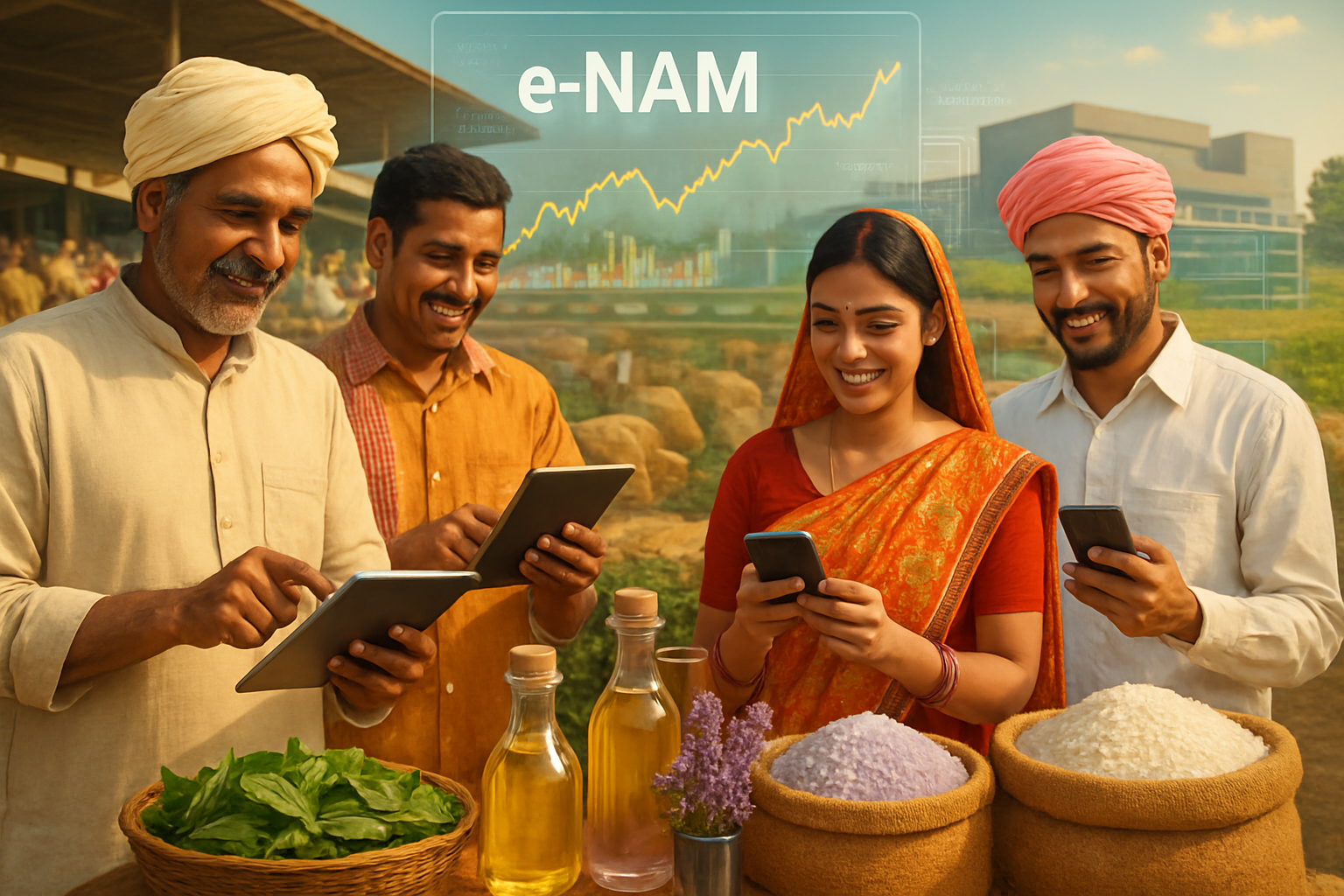
India's National Agriculture Market (e-NAM) platform has taken another monumental leap forward, integrating nine new agricultural commodities and solidifying its role as a pivotal force in the nation's digital agri-trade revolution. This strategic expansion, announced on October 8, 2025, by the Department of Agriculture and Farmers' Welfare, Government of India, brings the total number of tradable items on the platform to 247. The move comes in direct response to escalating requests from farmers, traders, and other stakeholders, all clamoring for broader commodity coverage and deeper market integration.
The immediate implications of this expansion are profound, promising enhanced market access, improved price discovery, and greater transparency for millions across the agricultural value chain. By standardizing tradable parameters for these new commodities—which include diverse items like Green Tea, Lavender Oil, and Broken Rice—e-NAM is not just adding products; it's fortifying the foundation for a unified, efficient, and equitable national agricultural market. This initiative is poised to significantly empower farmers with better price realization and equip traders with expanded opportunities, ultimately fostering a more robust and resilient agricultural economy.
Comprehensive Overview of e-NAM's Latest Expansion and Its Trajectory
The latest expansion, officially announced and implemented on October 8, 2025, saw the inclusion of nine distinct agricultural commodities: Green Tea, Tea, Aswagandha Dry Roots, Mustard Oil, Lavender Oil, Mentha Oil, Virgin Olive Oil, Lavender Dried Flower, and Broken Rice. This brings the total number of tradable items on the platform to an impressive 247. The Department of Agriculture and Farmers' Welfare, Government of India, spearheaded this initiative, emphasizing its commitment to empowering farmers through digital tools, promoting quality-driven trade, and ensuring inclusive growth in the agricultural sector.
Crucially, the success of this expansion hinges on the meticulous work of government bodies. The Directorate of Marketing and Inspection (DMI), operating under the Ministry of Agriculture, played a vital role in formulating the "tradable parameters" for each new commodity. These parameters establish standardized quality benchmarks, ensuring that prices accurately reflect the produce's quality and fostering fair transactions. This complex process involved extensive consultations with state agencies, traders, subject matter experts, and the Small Farmers' Agribusiness Consortium (SFAC), with Union Agriculture Minister Shivraj Singh Chouhan personally approving the new parameters.
The Small Farmers' Agribusiness Consortium (SFAC) serves as the central implementing agency for e-NAM, fully funded by the Central Government. SFAC's responsibilities extend to coordinating with various stakeholders, providing technical support, and continuously monitoring the project's progress. They also offer crucial day-to-day assistance to ensure smooth implementation for farmers and traders alike.
This latest expansion is part of a series of strategic enhancements throughout 2025. The platform, originally launched on April 14, 2016, has seen continuous growth. Earlier in 2025, specifically on February 6-7, ten new commodities were added, followed by another seven on July 9-10. These earlier additions included a diverse range of products, from value-added items like Besan and Chana Sattu to regionally significant crops such as Sugarcane, Marcha rice, and Jardalu mango. This progressive integration underscores a clear strategic shift towards a more comprehensive and nuanced digital marketplace.
Initial reactions to these expansions, particularly from government circles and many stakeholders, have been largely positive. The additions are viewed as crucial steps towards better market access, improved pricing, and enhanced quality realization for farmers, ultimately boosting their economic well-being and reducing reliance on intermediaries. The inclusion of niche and high-value products also signals e-NAM's evolution into a more sophisticated platform, capable of supporting a broader spectrum of agricultural trade. However, despite the positive momentum, reports from Q1 FY26 (April-June 2025) indicated a significant 62% decline in inter-state trade on e-NAM, with overall sales turnover showing only a marginal 2% increase. This highlights ongoing challenges in fully realizing seamless pan-India market integration and underscores the need for continued efforts in awareness, training, and process optimization to ensure the platform's full potential is achieved.
Impact on Public Companies: Winners and Losers in the Digital Agri-Trade Era
The expansion of India's e-NAM platform, particularly with the addition of nine new commodities, is set to significantly reshape the landscape for various public companies across the agri-tech, logistics, food processing, and commodity-specific sectors. The platform's core objective of unifying agricultural trade, enhancing price discovery, and reducing intermediation creates clear winners and potential losers.
Potential Winners
Agri-tech Companies: Firms providing digital solutions, market intelligence, quality testing, and farm management services stand to gain. While pure-play listed agri-tech companies directly tied to e-NAM are scarce, broader enterprise solution providers like Tech Mahindra (NSE: TECHM) and Tata Consultancy Services (NSE: TCS) could see increased demand for building supporting digital infrastructure or integrating their services within the expanding e-NAM ecosystem. Increased digitalization of agricultural trade fuels demand for their expertise in data analytics, AI/ML-driven solutions, and platform integration.
Logistics Companies: e-NAM's focus on streamlining the supply chain and connecting farmers directly with buyers creates a more organized and potentially higher-volume environment for logistics providers. Publicly listed players with strong rural and agricultural supply chain networks are well-positioned. Mahindra Logistics Ltd. (NSE: MAHLOG) could capitalize on the demand for efficient transportation and warehousing, especially for newly added commodities that might require specialized handling. Similarly, companies like Container Corporation of India Ltd. (NSE: CONCOR) could see an indirect boost from increased agricultural trade volumes, while express logistics providers such as Blue Dart Express Ltd. (NSE: BLUEDART) might benefit from the faster movement of high-value or perishable goods.
Food Processing Companies: These companies stand to benefit immensely from more predictable, quality-assured raw material sourcing. The inclusion of commodities like Mustard Oil, Virgin Olive Oil, and Broken Rice directly impacts their supply chains. Major players such as Adani Wilmar Ltd. (NSE: AWL), a dominant force in edible oils and food staples, and Patanjali Foods Ltd. (NSE: PATANJALI) (formerly Ruchi Soya Industries), will find more streamlined procurement channels. Rice processors and exporters like LT Foods Ltd. (NSE: LTFOODS) and KRBL Ltd. (NSE: KRBL) will gain from better access to various rice varieties, including the significant by-product "Broken Rice." The platform allows direct procurement, potentially lowering raw material costs and ensuring quality control through standardized parameters.
Companies Dealing with Newly Added Commodities:
- Tea Companies: For Tata Consumer Products Ltd. (NSE: TATACONSUM), a prominent player with brands like Tata Tea, and other established tea producers such as Jay Shree Tea & Industries Ltd. (NSE: JAYSHREETEA), the inclusion of Green Tea and Tea offers transparent and efficient sourcing opportunities directly from growers, potentially leading to better price realization.
- Edible Oil Companies: Companies like Adani Wilmar Ltd. (NSE: AWL), Marico Ltd. (NSE: MARICO), and Gokul Agro Resources Ltd. (NSE: GARL) will benefit from a standardized platform for bulk procurement of Mustard Oil and Virgin Olive Oil, enhancing transparency and competitive bidding.
- Rice Companies: LT Foods Ltd. (NSE: LTFOODS) and KRBL Ltd. (NSE: KRBL) will find better price discovery for specialty rice and by-products like Broken Rice, expanding their market reach for both sourcing and selling.
Potential Losers
Traditional Intermediaries and Commission Agents: e-NAM's fundamental goal is to bypass middlemen. While these are not typically publicly listed entities, their business models, which often thrive on information asymmetry and localized monopolies within APMC mandis, will be severely disrupted. Any large public companies that heavily rely on such traditional, opaque procurement channels without adapting to the e-NAM framework could face significant disadvantages, including higher procurement costs and reduced access to diverse, quality-assured produce.
Companies Resistant to Digital Adoption: Any food processing, trading, or logistics company, particularly smaller regional public companies with limited digital capabilities, that fails to embrace the digital framework of e-NAM will likely lose out. They risk being left behind by more agile competitors who leverage the platform for efficient sourcing, competitive pricing, and streamlined operations. This could lead to higher operational expenses and a competitive disadvantage.
In essence, e-NAM's expansion creates a clearer divide: companies that are technologically adept and willing to integrate with the digital agri-trade ecosystem are poised for growth, while those clinging to outdated, less transparent methods will face increasing pressure and potential decline.
Wider Significance: A Catalyst for Agricultural Transformation
The continuous expansion of India's e-NAM platform, particularly with the recent addition of nine new commodities, is a powerful testament to the nation's broader commitment to modernizing its agricultural sector. This initiative is deeply embedded within overarching industry trends, promising significant ripple effects across the economy.
Broader Industry Trends
At its core, e-NAM embodies the accelerated digitalization of agriculture in India, aligning seamlessly with the "Digital India" campaign. It leverages technology to dismantle historical inefficiencies prevalent in agricultural marketing, such as opaque pricing, limited market access, and over-reliance on intermediaries. By facilitating online trading, e-NAM enables real-time price discovery, empowering farmers to make informed decisions. The platform's integration of AI-based quality assaying, e-bidding, and direct e-payment mechanisms streamlines the entire marketing process, pushing the agricultural sector towards greater transparency and efficiency. The ongoing e-NAM 2.0 expansion, with its focus on warehouse-based trading and FPO integration, further solidifies this digital transformation.
This expansion also unequivocally highlights the government's robust support for farmers. e-NAM is a cornerstone initiative designed to enhance farmers' economic welfare by providing wider market access, reducing their dependence on middlemen, and ensuring better price realization. The platform’s transparent online trading and direct bank payments mitigate risks of delayed or unfair settlements. Furthermore, e-NAM synergizes with other government programs like PM Kisan Samman Nidhi and the promotion of Farmer Producer Organizations (FPOs), collectively strengthening farmers' bargaining power and market linkages.
Potential Ripple Effects
The burgeoning influence of e-NAM creates significant ripple effects on competitors and partners. Traditional agricultural market systems, especially the established APMC mandis and their associated commission agents, face substantial disruption. e-NAM's direct farmer-to-buyer model and transparent e-auctions directly challenge the information asymmetry that these intermediaries have historically exploited. This increased competition compels traditional players to either adapt, become more efficient, and embrace transparency, or risk losing market share. Simultaneously, the platform creates new avenues for partners. Farmer Producer Organizations (FPOs) gain enhanced collective bargaining power and direct market access. Logistics providers see increased demand for efficient transportation and warehousing as pan-India trade expands. Banks and fintech companies find opportunities in facilitating direct and timely online payments to farmers. Similarly, assaying, quality certification agencies, and technology providers are poised for growth as the platform demands robust support services.
Regulatory or Policy Implications
The success of e-NAM is intrinsically linked to regulatory and policy reforms, particularly concerning the Agricultural Produce Market Committee (APMC) Acts. For full integration, states must amend their APMC Acts to permit e-trading, implement a single trading license valid across the state, and levy market fees at a single point. While progress has been made, variations in state-level regulations and resistance to technology adoption remain hurdles. The government's "One Nation, One Market" vision, championed by e-NAM, serves as a crucial foundation for future agri-market reforms, emphasizing digital infrastructure development, farmer digital literacy, and standardized quality assessment.
Historical Precedents and Comparisons
While e-NAM stands as a unique, large-scale national initiative, its foundational principles of digitalizing agricultural markets find parallels globally. Karnataka's successful e-market project, preceding e-NAM, served as a vital domestic precedent, demonstrating the viability of electronic trading within an Indian context. Internationally, numerous digital agriculture platforms aim to improve supply chains, market access, and price transparency by connecting farmers directly with buyers. However, e-NAM's distinguishing features include its immense scale, its strategic integration with existing physical APMC mandis, and comprehensive government backing to forge a unified national market. Like similar initiatives in other developing countries, e-NAM also navigates challenges such as internet connectivity, digital literacy among farmers, and resistance from entrenched interests, highlighting common hurdles in the journey toward agricultural modernization.
What Comes Next: Navigating the Future of Digital Agri-Trade
The recent expansion of India's e-NAM platform with nine new commodities marks another significant step in its journey, but the road ahead involves both exciting possibilities and considerable challenges. The platform is poised for continued evolution, demanding strategic pivots and adaptations to realize its full transformative potential.
Short-Term and Long-Term Possibilities
In the immediate future, the expansion is expected to bolster market access and competition for farmers, particularly with the inclusion of value-added products that benefit Farmer Producer Organizations (FPOs). This should lead to enhanced price realization and greater transparency through online bidding and real-time price discovery. Efficiency gains and reduced transaction costs for both farmers and traders are also anticipated. Long-term, e-NAM aims to fully realize the vision of "One Nation, One Market," creating a unified national market with seamless inter-state movement of agricultural commodities. It is evolving into a central nervous system for India's agri-value chain, becoming a data-driven ecosystem that empowers farmers to shift from "price takers" to "price makers," especially for high-value and unique regional crops. Future iterations, like "e-NAM 2.0," will integrate with accredited warehouses, allowing farmers to store produce, obtain Negotiable Warehouse Receipts (NWRs), and use them as collateral for bank loans, providing crucial financial liquidity.
Potential Strategic Pivots or Adaptations Required
To overcome existing hurdles, e-NAM will need several strategic adjustments. A critical pivot involves bridging the persistent digital divide and enhancing digital literacy among farmers, especially in regions where adoption has been slower. This requires extensive awareness campaigns, targeted training programs, and promoting self-registration through mobile applications. Improving rural infrastructure, including reliable internet connectivity, electricity, quality testing facilities, and proper storage, is paramount. Standardization and accurate quality assaying for all commodities are crucial for building trust in inter-state trade. Addressing policy and governance complexities that impede inter-state trade, such as varying state-level APMC act amendments, remains a key challenge. Furthermore, streamlining payment systems and resolving delays are essential to build farmer confidence and encourage wider participation. Continuous engagement with all stakeholders—farmers, traders, and commission agents—is necessary to address concerns and ensure active involvement.
Market Opportunities and Challenges
The expansion opens new market opportunities for diversification into value-added products, boosting export potential for high-value regional produce, and leveraging technology for market forecasting. The integration of financial services through NWRs presents significant avenues for financial inclusion, offering farmers better credit access and informed selling decisions. However, challenges persist. Despite its benefits, e-NAM's contribution to total APMC trade volume remains relatively low (around 6% as of FY 2023-2024), with only 20% of APMCs onboarded. Resistance from traditional stakeholders, infrastructure gaps, the digital divide, and persistent inter-state trade hurdles continue to limit its full potential.
Potential Scenarios and Outcomes
An optimistic scenario envisions e-NAM achieving widespread adoption through sustained government efforts, successful stakeholder engagement, and significant infrastructure development. It becomes the primary mode of agricultural trade, characterized by high inter-state trade, efficient price discovery, and substantially increased farmer incomes, fully realizing the "One Nation, One Market" vision. A moderate growth scenario sees e-NAM expanding steadily but with persistent challenges limiting its full potential, leading to significant benefits for farmers in well-connected regions but slower adoption elsewhere. In a stagnation/suboptimal scenario, e-NAM struggles to overcome the digital literacy gap, inadequate infrastructure, and strong resistance from vested interests, resulting in minimal inter-state trade, low overall trade volume, and limited transformative impact. The ultimate success of e-NAM hinges on its ability to strategically address these multifaceted challenges, paving the way for a truly inclusive and efficient digital agricultural marketplace.
Wrap-up: Charting the Course for India's Digital Agri-Future
The expansion of India's e-NAM platform, culminating in the recent addition of nine new commodities on October 8, 2025, underscores a determined national effort to revolutionize agricultural marketing. While demonstrating significant progress, it also highlights the multifaceted challenges inherent in transforming a vast and traditionally fragmented sector.
Summary of Key Takeaways
e-NAM has demonstrably expanded its reach, integrating over 1,400 APMC mandis across 18 states and three Union Territories. The continuous increase in commodity coverage, now totaling 247 items, directly responds to stakeholder demand and aims to bring a wider array of produce under the digital umbrella, with the Directorate of Marketing and Inspection (DMI) playing a crucial role in standardizing quality parameters. Growing participation from 1.75 crore farmers, 2.43 lakh traders, and over 2,500 FPOs indicates increasing, though sometimes reluctant, adoption. For farmers, e-NAM has enhanced market access, improved transparency, facilitated better price discovery, and ensured timely direct payments, thereby reducing reliance on middlemen. However, significant challenges persist, including stakeholder adoption hurdles, lack of scientific sorting/grading facilities, poor rural internet connectivity, and the prevalence of offline transactions undermining true price discovery. Crucially, inter-state and inter-mandi trade remains minimal, suggesting the "One Nation, One Market" vision is yet to be fully realized.
Assessment of the Market Moving Forward
e-NAM is strategically positioned to continue driving the modernization and digitization of Indian agriculture. The upcoming e-NAM 2.0 upgrade is a critical next step, designed to address current limitations by integrating logistics service providers, enhancing bank account validation, and implementing eKYC for seamless, nationwide farm trade. Future market developments will likely see deeper integration with the broader agricultural supply chain, including warehousing and cold storage, to minimize post-harvest losses. The sustained emphasis on quality-driven trade through standardized parameters promises better value realization for farmers, pushing towards a more organized, competitive, and fair trading environment.
Significance and Lasting Impact
e-NAM stands as a transformative policy initiative, with its lasting impact residing in its potential to fundamentally empower Indian farmers. By offering greater market access, diminishing the influence of exploitative intermediaries, and ensuring transparent price discovery, it contributes directly to the vision of doubling farmers' incomes and fostering sustainable agricultural growth. The platform's ability to provide real-time market information and facilitate direct online payments can significantly bolster farmers' economic resilience and financial stability. However, the ultimate realization of this profound impact hinges on effectively overcoming persistent challenges related to infrastructure, digital literacy, and ensuring genuine, widespread participation in online transactions across all states.
What Investors Should Watch For in Coming Months
For investors keen on India's agricultural sector, several key indicators related to e-NAM's evolution should be closely monitored:
- Rollout and Features of e-NAM 2.0: Pay close attention to the details and timeline of e-NAM 2.0's implementation. Success in integrating logistics, warehousing, and cold chain solutions will be crucial for enhancing supply chain efficiency and reducing post-harvest losses. Features like bank account validation and eKYC could streamline transactions and increase trust in the platform.
- Increase in Inter-state and Inter-mandi Trade: While overall turnover has grown, the low volume of inter-state and inter-mandi trade is a significant bottleneck. Any substantial increase in these volumes would signal greater market integration and better price discovery, attracting more participants and investment.
- Infrastructure Development in Mandis: Watch for government and private sector investments in improving essential infrastructure such as internet connectivity, scientific sorting/grading facilities, and quality testing units within mandis. Progress in these areas, particularly in underserved regions, will enhance the platform's functionality and user confidence.
- Stakeholder Adoption and Training Effectiveness: Monitor reports on the genuine participation of farmers, traders, and commission agents in online transactions, not just registrations. The effectiveness of awareness and training programs in improving digital literacy and platform usage will be vital for sustained growth.
- Further APMC Act Reforms: Observe continued efforts by state governments to amend their APMC Acts to align with e-NAM's objective of "One Nation, One Market," specifically regarding single licenses and single-point levy of market fees across states. These legislative changes are critical for creating a truly unified market.
- FPO Empowerment and Value-Added Products: The platform's success in enabling Farmer Producer Organizations (FPOs) to market value-added products and formalize trade will be an important indicator of its deeper impact on farmer income and agricultural diversification.
By tracking these developments, investors can gauge the platform's effectiveness in achieving its objectives and identify opportunities within India's evolving agricultural landscape.
This content is intended for informational purposes only and is not financial advice


















